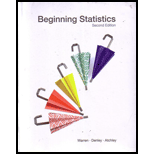
a.
To find:
The probability, from the given information, that a randomly chosen Norwegian baby’s birth weight was less than 4000 g.
Answer to Problem 1E
Solution:
The required probability is
Explanation of Solution
In statistics, the normal Gaussian distribution with the following characteristics:
is called standard
When this function is plotted on the
Area on the left of a given
which can be obtained from the normal distribution table.
Area on the right of a given
which can be obtained by subtracting a certain value from the normal distribution table from one.
Area in between of given
both of which can both be obtained from the normal distribution table.
Area below a smaller given
both of which can both be obtained from the normal distribution table.
In order to get the above values from the table, the standard scores are to be obtained using the relation:
and then the tables are to be accessed to find the values of the integrations and thus the probabilities.
It is to note that the probabilities when multiplied by 100 give the percentage chance.
Given:
Birth weights of Norwegians are normally distributed with the following characteristics:
mean
standard deviation
Calculation:
The standard value corresponding to the
The obtained value is the
Since the digit at
From the table, the area on the left of the above
Since the digit at the
b.
To find:
The probability, from the given information, that a randomly chosen Norwegian baby’s birth weight was greater than 3750 g.
Answer to Problem 1E
Solution:
The required probability is
Explanation of Solution
Given:
Birth weights of Norwegians are normally distributed with the following characteristics:
mean
standard deviation
Calculation:
The standard value corresponding to the
The obtained value is the
Since the digit at
From the table, the area on the right of the above
which simplifies to:
Since the digit at the
c.
To find:
The probability, from the given information, that a randomly chosen Norwegian baby’s birth weight was greater than 3750 g.
Answer to Problem 1E
Solution:
The required probability is
Explanation of Solution
Given:
Birth weights of Norwegians are normally distributed with the following characteristics:
mean
standard deviation
Calculation:
The standard value corresponding to the
and that corresponding to the
The obtained values are the
Since the digit at
Since the digit at
From the table, the area on the left of the
Similarly, the area on the left of the
Thus, the probability that
This gives the required probability as:
d.
To find:
The probability, from the given information, that a randomly chosen Norwegian baby’s birth weight was greater than 3750 g.
Answer to Problem 1E
Solution:
The required probability is
Explanation of Solution
Given:
Birth weights of Norwegians are normally distributed with the following characteristics:
mean
standard deviation
Calculation:
The standard value corresponding to the
and that corresponding to the
The obtained values are the
Since the digit at
Since the digit at
From the table, the area on the left of the
Similarly, the area on the right of the
Thus, the probability that
Here, since the
Want to see more full solutions like this?
Chapter 6 Solutions
Beginning Statistics, 2nd Edition
 MATLAB: An Introduction with ApplicationsStatisticsISBN:9781119256830Author:Amos GilatPublisher:John Wiley & Sons Inc
MATLAB: An Introduction with ApplicationsStatisticsISBN:9781119256830Author:Amos GilatPublisher:John Wiley & Sons Inc Probability and Statistics for Engineering and th...StatisticsISBN:9781305251809Author:Jay L. DevorePublisher:Cengage Learning
Probability and Statistics for Engineering and th...StatisticsISBN:9781305251809Author:Jay L. DevorePublisher:Cengage Learning Statistics for The Behavioral Sciences (MindTap C...StatisticsISBN:9781305504912Author:Frederick J Gravetter, Larry B. WallnauPublisher:Cengage Learning
Statistics for The Behavioral Sciences (MindTap C...StatisticsISBN:9781305504912Author:Frederick J Gravetter, Larry B. WallnauPublisher:Cengage Learning Elementary Statistics: Picturing the World (7th E...StatisticsISBN:9780134683416Author:Ron Larson, Betsy FarberPublisher:PEARSON
Elementary Statistics: Picturing the World (7th E...StatisticsISBN:9780134683416Author:Ron Larson, Betsy FarberPublisher:PEARSON The Basic Practice of StatisticsStatisticsISBN:9781319042578Author:David S. Moore, William I. Notz, Michael A. FlignerPublisher:W. H. Freeman
The Basic Practice of StatisticsStatisticsISBN:9781319042578Author:David S. Moore, William I. Notz, Michael A. FlignerPublisher:W. H. Freeman Introduction to the Practice of StatisticsStatisticsISBN:9781319013387Author:David S. Moore, George P. McCabe, Bruce A. CraigPublisher:W. H. Freeman
Introduction to the Practice of StatisticsStatisticsISBN:9781319013387Author:David S. Moore, George P. McCabe, Bruce A. CraigPublisher:W. H. Freeman





